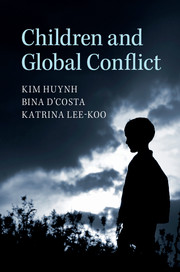Book contents
- Frontmatter
- Dedication
- Contents
- List of abbreviations
- Introduction: why children matter to global conflict
- 1 Children and armed conflict: mapping the terrain
- 2 Children and agency: caretakers, free-rangers and everyday life
- 3 Children and IR: creating spaces for children
- 4 The rights of the child: political history, practices and protection
- 5 Child soldiers: causes, solutions and cultures
- 6 Child forced migrants: bio-politics, autonomy and ambivalence
- 7 Children and peace building: propagating peace
- 8 Children and justice: past crimes, healing and the future
- 9 Who speaks for children? Advocacy, activism and resistance
- Conclusion
- Appendix
- Bibliography
- Index
4 - The rights of the child: political history, practices and protection
Published online by Cambridge University Press: 05 May 2015
- Frontmatter
- Dedication
- Contents
- List of abbreviations
- Introduction: why children matter to global conflict
- 1 Children and armed conflict: mapping the terrain
- 2 Children and agency: caretakers, free-rangers and everyday life
- 3 Children and IR: creating spaces for children
- 4 The rights of the child: political history, practices and protection
- 5 Child soldiers: causes, solutions and cultures
- 6 Child forced migrants: bio-politics, autonomy and ambivalence
- 7 Children and peace building: propagating peace
- 8 Children and justice: past crimes, healing and the future
- 9 Who speaks for children? Advocacy, activism and resistance
- Conclusion
- Appendix
- Bibliography
- Index
Summary
Introduction
As demonstrated in Chapter 1, there are a range of direct and indirect threats to children and their rights in armed conflict. Accepting that it is ‘law that creates and sustains the regulatory frameworks that define childhood and therefore also the social practices that encapsulate and systematise everyday interactions between adults and children’, a variety of national, regional and international legal standards and practices are integral to the rights of the child.
In Chapter 1 it was argued that certain cultural and legal specificities have influenced the definition of childhood in the UNCRC, and Chapter 2 noted that de Certeau's PEL could be adopted in childhood scholarship to offer insights into developing responsible and responsive approaches to children's lives in highly stressful environments. This chapter draws on these two observations about childhood to consider various perspectives that have contributed to the legal basis of children's rights. The chapter examines how the development of international and national discourses on children's rights is relevant to children's specific rights in armed conflict situations. It argues that ideas regarding children's rights are culturally constructed and contested; that they emerged from historical and social crises and are the product of particular power relations. It is further argued that a combination of legislative and regulatory frameworks and innovative advocacy measures co-ordinated between international, regional and national levels is the way forward in ensuring the rights of the child.
The first part of this chapter focuses on children's rights across cultural contexts. It examines a number of aspects in detail: the search for common ground and a common global language of children's rights that permeates the local/state-based settings and reaches communities and families; secondly, the manner in which children endure, despite deeply divisive social/cultural orders that are in many cases perpetually transformed due to armed conflict. Reviewing the history of children's rights in international forums it then argues that although debate regarding children's rights is ongoing, it was only in the second half of the twentieth century that it shifted from a language of ‘salvation’ to substantive protection of those rights.
- Type
- Chapter
- Information
- Children and Global Conflict , pp. 89 - 122Publisher: Cambridge University PressPrint publication year: 2015

